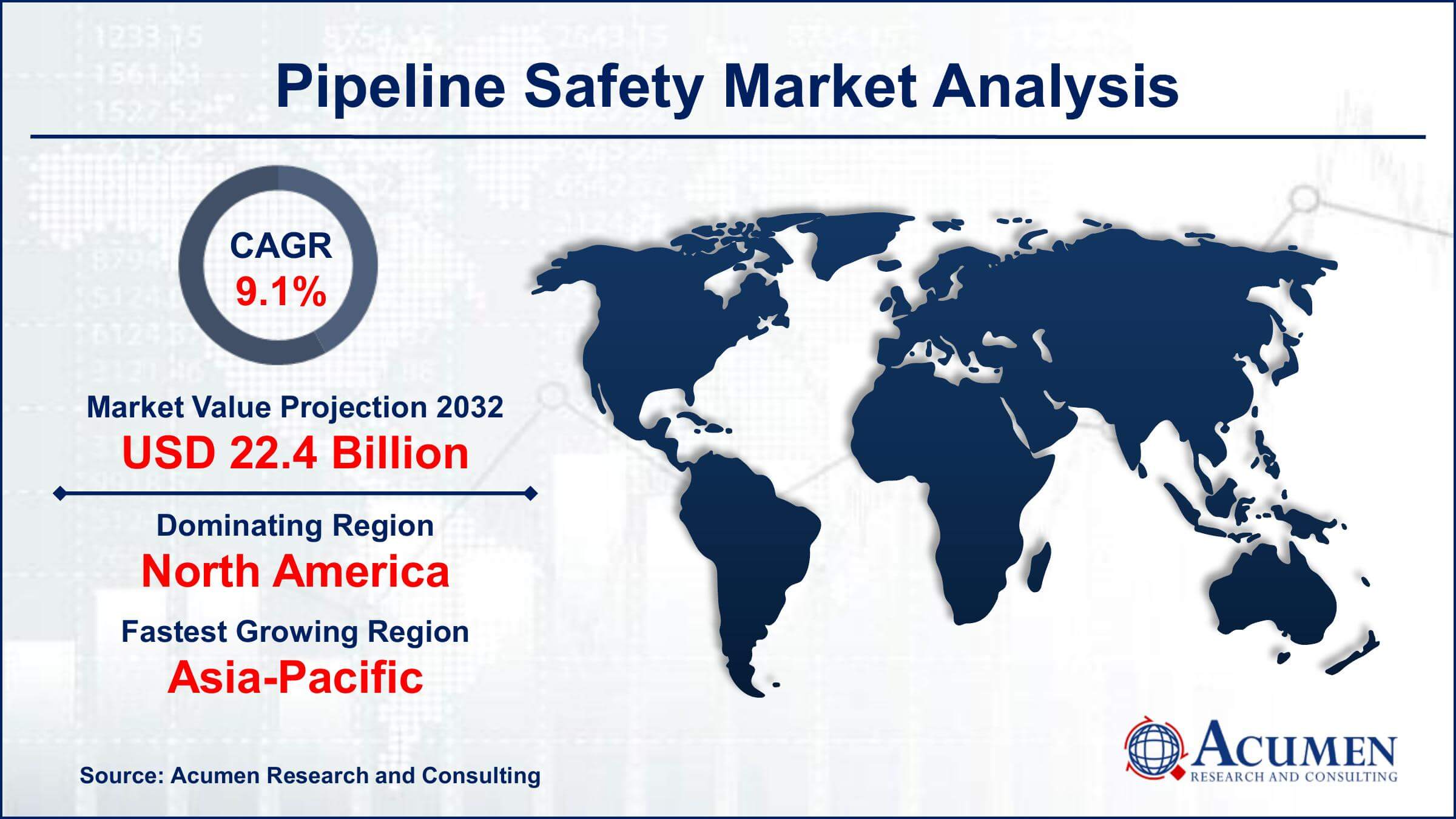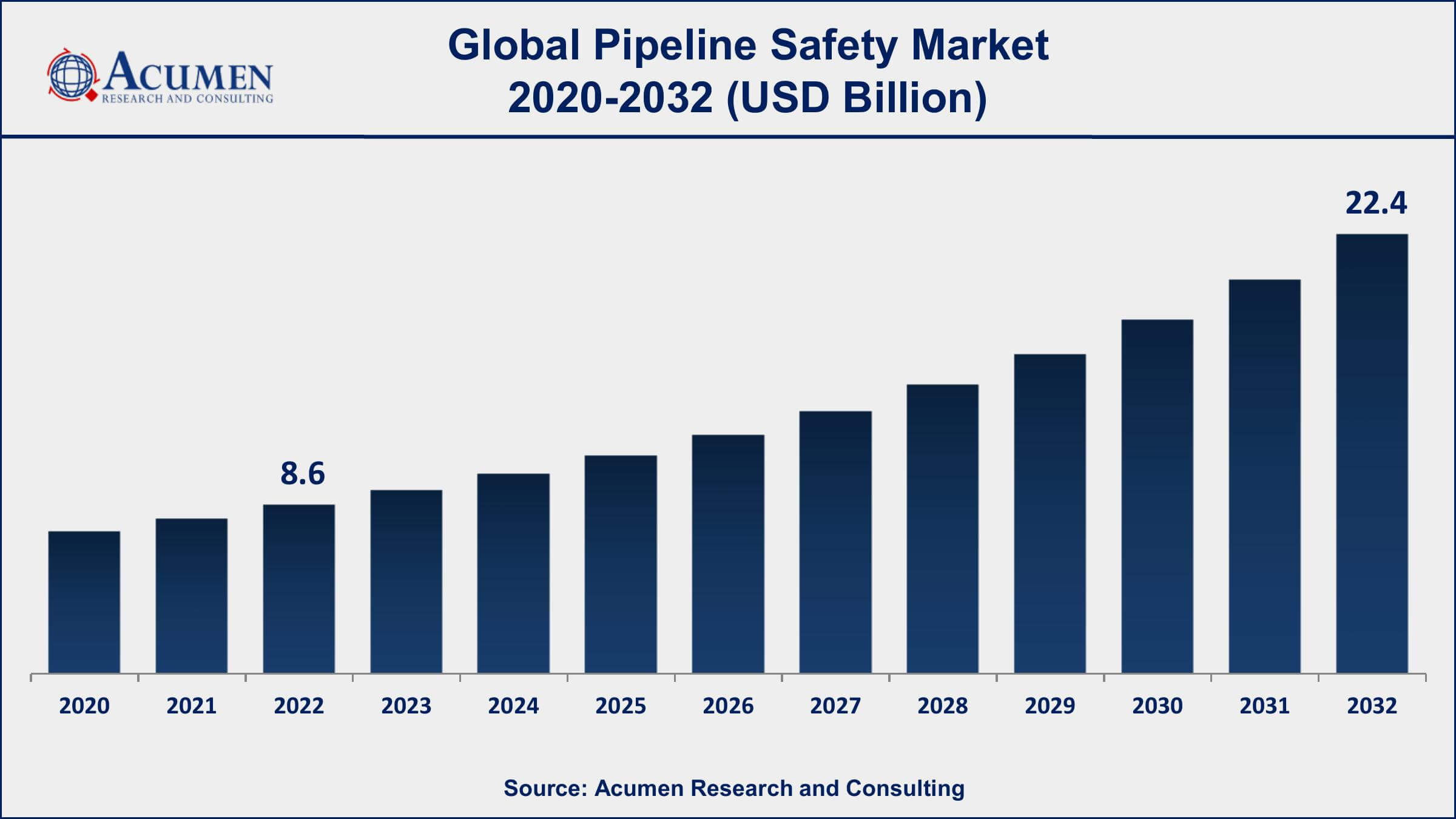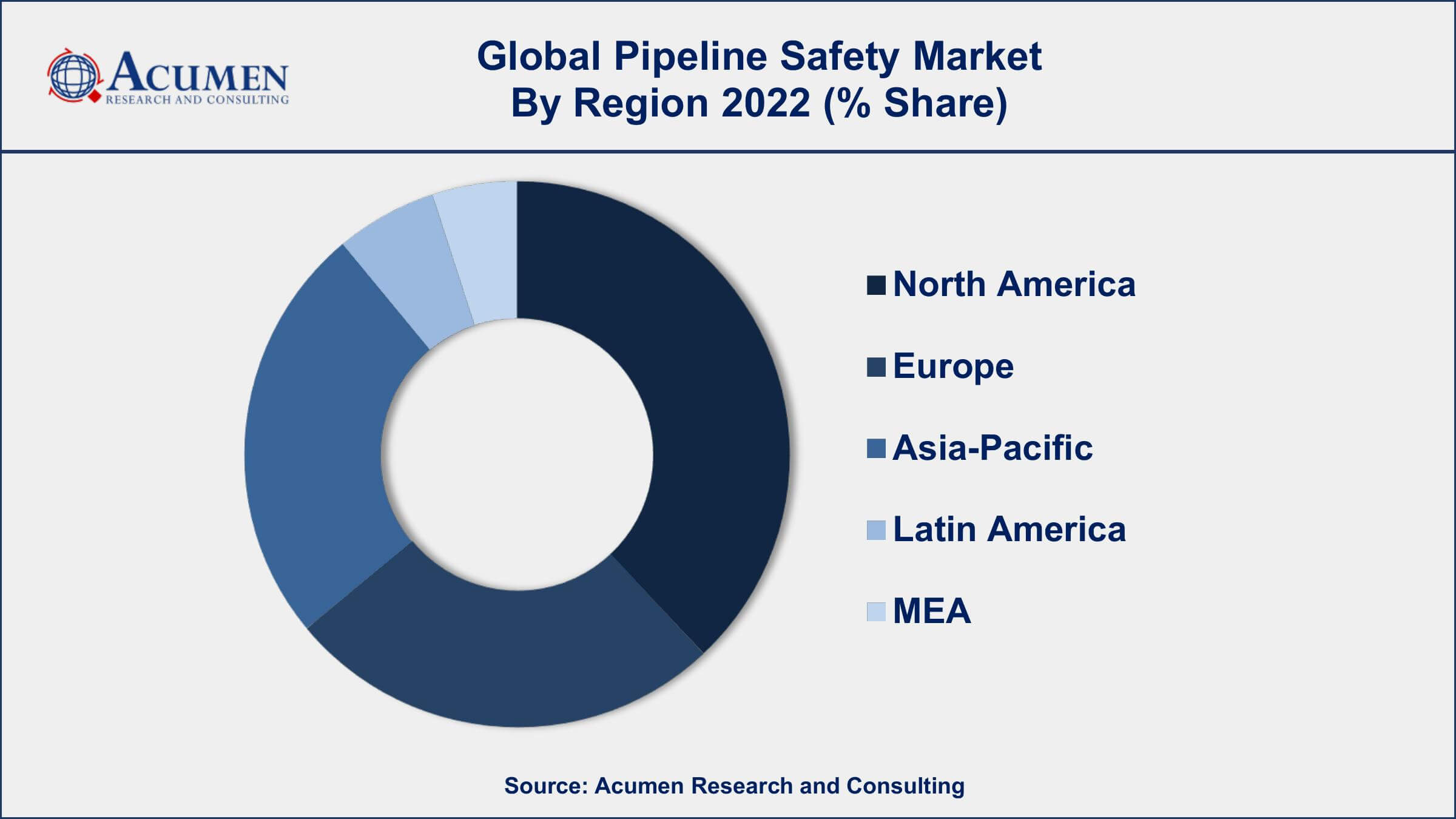February 2020
Pipeline Safety Market Size accounted for USD 8.6 Billion in 2022 and is projected to achieve a market size of USD 22.4 Billion by 2032 growing at a CAGR of 9.1% from 2023 to 2032.
The Global Pipeline Safety Market Size accounted for USD 8.6 Billion in 2022 and is projected to achieve a market size of USD 22.4 Billion by 2032 growing at a CAGR of 9.1% from 2023 to 2032.
Pipeline Safety Market Report Key Highlights

Pipeline safety refers to the measures taken to ensure the safety of oil and gas pipelines, including regular maintenance and monitoring, risk assessments, and emergency response plans. The pipeline safety market has been growing steadily in recent years, driven by increasing demand for oil and gas transportation infrastructure, as well as greater regulatory scrutiny and public concern around pipeline safety.
The pipeline safety market has been experiencing significant growth in recent years due to the increasing demand for energy and the need to transport oil and gas across long distances. Factors contributing to the growth of the pipeline safety market include government regulations, increasing investments in pipeline infrastructure, and the adoption of advanced technologies for pipeline monitoring and control. The need for pipeline safety is especially important in regions with high seismic activity or extreme weather conditions, as well as areas with high population density.

Global Pipeline Safety Market Trends
Market Drivers
Market Restraints
Market Opportunities
Pipeline Safety Market Report Coverage
| Market | Pipeline Safety Market |
| Pipeline Safety Market Size 2022 | USD 8.6 Billion |
| Pipeline Safety Market Forecast 2032 | USD 22.4 Billion |
| Pipeline Safety Market CAGR During 2023 - 2032 | 9.1% |
| Pipeline Safety Market Analysis Period | 2020 - 2032 |
| Pipeline Safety Market Base Year | 2022 |
| Pipeline Safety Market Forecast Data | 2023 - 2032 |
| Segments Covered | By Component, By Application, And By Geography |
| Regional Scope | North America, Europe, Asia Pacific, Latin America, and Middle East & Africa |
| Key Companies Profiled | Honeywell International Inc., Siemens AG, ABB Group, Schneider Electric SE, General Electric Company, Emerson Electric Co., Rockwell Automation, Inc., Yokogawa Electric Corporation, KROHNE Group, and Endress+Hauser Group. |
| Report Coverage |
Market Trends, Drivers, Restraints, Competitive Analysis, Player Profiling, Covid-19 Analysis, Regulation Analysis |
Pipeline safety is the set of technological solutions implemented by companies in order to secure pipeline infrastructure from terrorist attacks, external damage, natural disasters, and cyberattacks. The market for oil & gas pipeline safety is majorly influenced by the repair & development of the aging pipeline infrastructure. Rising threats from criminal and terrorist activities are the key growth factor for the pipeline safety market. The risks from terrorist attacks vary across sectors that include refining, exploration and production, pipeline transportation, product distribution and marketing, and marine transportation. Since oil & gas exploration and development sites are easy targets for terrorists, the need for protecting such sites is continually increasing. This growing need to protect oil and gas pipeline infrastructure is expected to bolster the market growth during the forecast period.
Rising spending by oil & gas companies for ensuring and upgrading safety standards of existing pipeline infrastructure and network protection along with the upgradation of oil refineries, pipelines, and drilling sites are some of the factors expected to drive the pipeline market. The major drivers include the need for sustainable use of resources, expansion, and up-gradation of refineries, and increased spending by oil & gas companies for network and infrastructure protection. Furthermore, rising security regulations, increasing oil & gas demand in developing countries, and mandatory standards provide significant opportunities for pipeline security service providers, vendors, consulting companies, and solutions providers.
Rising incidents of oil & gas attacks are one of the key reasons to adopt and deploy pipeline safety solutions, worldwide. Transportation of oil & gas through pipelines is the safest mode of transporting fuel. However, cyberattacks on oil & gas pipelines are very common. For instance, in 2008, an intended cyberattack where hackers shut down all the alarms and cut off communications took place in a Turkey pipeline blast. Thus, pipeline safety solutions are progressively more adopted and implemented in existing infrastructures as well as a large number of ongoing pipeline projects across the world to combat such cyber attacks on critical infrastructure, especially in the Asia-Pacific region.
Pipeline Safety Market Segmentation
The global pipeline safety market segmentation is based on component, application, and geography.
Pipeline Safety Market By Component
According to a pipeline safety industry analysis, the solution segment accounted for the largest market share in 2022. The solution segment includes a variety of products and services that help to ensure the safe and efficient operation of pipelines. These solutions include leak detection systems, pipeline integrity management systems, control systems, and emergency shutdown systems, among others. Leak detection systems are one of the most important solutions in the pipeline safety market, as they help to detect leaks in pipelines and prevent major accidents. These systems use a variety of technologies, such as acoustic, infrared, and mass balance, to detect leaks and alert operators in real time. Pipeline integrity management systems, on the other hand, help to ensure the overall structural integrity of pipelines and prevent damage caused by corrosion, cracking, or other factors.
Pipeline Safety Market By Application
According to the pipeline safety market forecast, the natural gas segment is expected to grow significantly in the coming years. Natural gas is an important source of energy and is transported through pipelines over long distances to reach consumers. The safety of these pipelines is critical to ensure the safe and efficient delivery of natural gas. The growth of the natural gas segment in the market is driven by several factors. First, natural gas is becoming an increasingly important source of energy as countries look to transition away from fossil fuels. Second, the increase in shale gas production in North America has led to a significant expansion of natural gas pipelines in the region. Third, the rise of liquefied natural gas (LNG) exports has led to an increase in natural gas pipeline construction and safety measures.
Pipeline Safety Market Regional Outlook
North America
Europe
Asia-Pacific
Latin America
The Middle East & Africa

Geographically, North America is currently dominating the pipeline safety market. One of the main reasons is the high number of pipelines in the region, particularly in the United States, which has one of the largest pipeline networks in the world. The vast network of pipelines in North America requires significant investment in safety measures to ensure the safe transportation of oil and gas across long distances. Another reason why North America is dominating the pipeline safety market is the stringent safety regulations in place. Regulatory agencies such as the Pipeline and Hazardous Materials Safety Administration (PHMSA) in the United States have implemented strict safety standards for pipeline construction, operation, and maintenance. These regulations have driven demand for safety-related products and services in the region.
Additionally, the increase in shale gas production in North America has led to a significant expansion of natural gas pipelines in the region, which has further driven the demand for pipeline safety solutions. Companies in the pipeline safety market are investing heavily in new technologies to meet the growing demand for real-time pipeline monitoring, automation, and control solutions.
Pipeline Safety Market Player
Some of the top pipeline safety market companies offered in the professional report includes Honeywell International Inc., Siemens AG, ABB Group, Schneider Electric SE, General Electric Company, Emerson Electric Co., Rockwell Automation, Inc., Yokogawa Electric Corporation, KROHNE Group, and Endress+Hauser Group.
Looking for discounts, bulk pricing, or custom solutions? Contact us today at sales@acumenresearchandconsulting.com
February 2020
January 2021
May 2024
March 2023